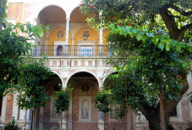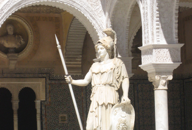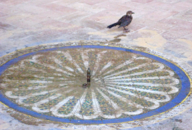“Casa de Pilatos”
PALACE OF THE ADELANTADOS MAYORES DE ANDALUCIA
SEVILLE, ANDALUSIA, SPAIN
JULY 28, 2008


“Casa de Pilatos”
PALACE OF THE ADELANTADOS MAYORES DE ANDALUCIA
SEVILLE, ANDALUSIA, SPAIN
JULY 28, 2008




Which is the truth? I have heard two stories about this 16th century palace, which is discreetly placed in the Santa Cruz district of Seville. The first story is that the Marquis of Tarifa built the Casa de Pilatos, thus named because it resembled the house of Pontius Pilate in Jerusalem. The architecture melds together High Renaissance Italy and the moorish architecture of Jerusalem, and might be the architecture of a Roman leader. The second story is that this house, once built, was used to stage an annual festival which re-enacts the 12 Stations of the Cross, with all the events which lead to Jesus’ crucifixion. This house was used for the re-enactment of the judgement, because it resembled the house of Pontius Pilot in Jerusalem. Either way, the name Pontius Pilot is unforgettable, as is this house and its gardens. It is now the residence of the Dukes of Medinaceli, and is one of the finest palaces in Seville. Henry and I bought tickets to tour the first and second floors of the house. We entered the Patio Principal, the courtyard with three 5th century Greek sculptures representing Athena, Ceres, and Minerva. A fountain is in the center of this courtyard, and an arched colonnaded arcade surrounds all four sides, behind which are mounted busts of ancient Romans, each in a circular niche. Moorish archways with slender columns open into adjacent rooms. The walls inside the arcade are tiled in decorative patterns, each block separated from the next by its own border The Salon de Descanso de los Juecos is off this courtyard, and served as a “piano nobile”. Adjacent to this room is a small chapel with Gothic rib vaulting. The altar contains a fourth century copy of a sculpture, which is in the Vatican, entitled “The Good Shepherd”. To reach the 2nd floor, we ascended a 12-foot wide stone staircase, the walls covered in moorish patterned tiles. The ceiling over the staircase is a half-round cupola with a Mudéjar ceiling. Rooms on this level have the same Mudéjar architectural ceiling treatment. The beauty on the second interior courtyard of this house is the arrangement of outdoor spaces, surrounded by the apartments, each appearing to be a separate building. The landscaping is lush and provides a green oasis. A dome of vines trail over a half round, graceful framework in the center of the courtyard. To complete the Italianate feeling of this palace, a doorway resembling a grotto, complete with iron gate, punctuates the Sienna red wall surrounding it.
PHOTOS: Left Column: 1. Fresco, detail. 2. View of the gated entrance facade.. 3. Arcade in the Patio Principal, showing the stonework. 4. View of the architecture in the second courtyard. Center, Top: View of the Patio Principal with its loggia. Center, Bottom: Detail, arcade walls with Roman busts in their niches and moorish tiled walls. Right Column: 1. Mudéjar styled roof in the Salon de Descanso de los Juecos. 2. Detail, Gothic rib vaulted ceiling in the chapel. 3. Detail, Athena, 5th century B.C. 4. Detail, decorative tile fountain in the arcade of a building in the second courtyard.


Palace






